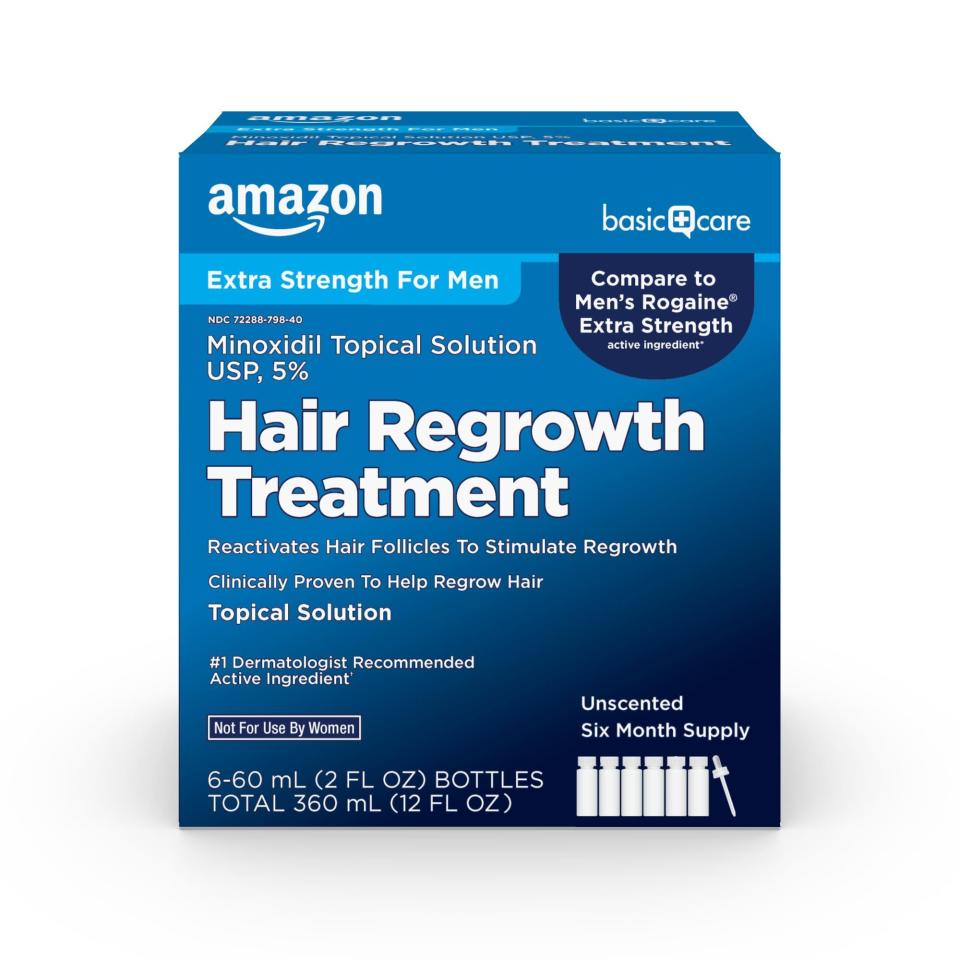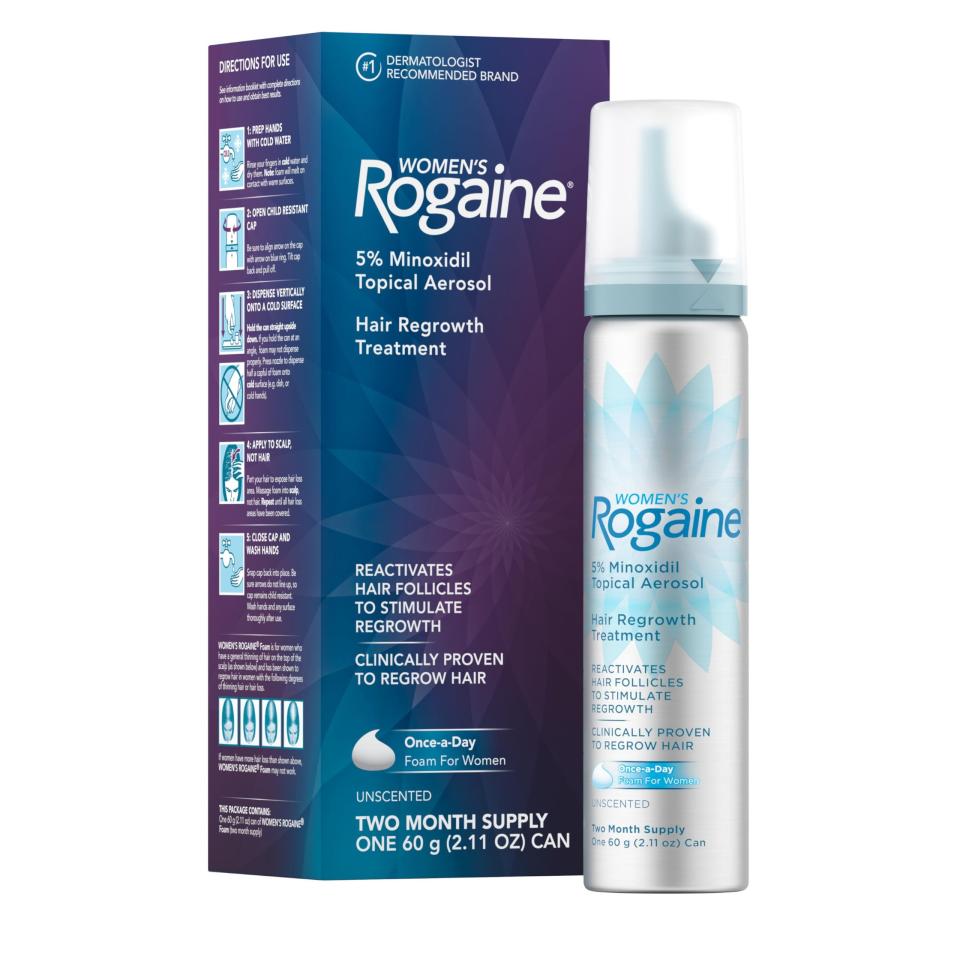This Is How Much Hair Loss Is Normal—and What’s Not, According to Experts

"Hearst Magazines and Yahoo may earn commission or revenue on some items through these links."
[table-of-contents] stripped
The unexpected sight of a brush, pillow, or drain full of hair can be jarring. It may even prompt you to wonder how much hair loss is normal. The good news is that everyone with long enough hair is bound to spot some strands in those common catchall spots, but there is a point when shedding can become abnormal. Ahead, dermatologists explain hair loss causes, prevention, and treatments.
Meet the Experts: Usha Rajagopal, M.D., board-certified plastic surgeon and medical director of San Francisco Plastic Surgery and Laser Center, Andy Goren, M.D., board-certified dermatologist, trichologist, and chief medical officer of Daniel Alain, and Lisa Rhodes, M.D., board-certified dermatologist at Westlake Dermatology.
How much hair loss is normal?
“For most individuals, 50 to 100 loss of hairs per day is normal,” explains Usha Rajagopal, M.D., board-certified plastic surgeon and medical director of San Francisco Plastic Surgery and Laser Center. “Anything over 150 especially on a consistent basis is abnormal.”
Hair loss in men versus hair loss in women
Experts say the average number of hairs shed by men and women per day is about the same. However, women or people with long hair are more likely to notice hair loss, explains Andy Goren, M.D., board-certified dermatologist, trichologist, and chief medical officer of Daniel Alain. This is even more so the case during shampooing. Goren says 60% of women who suffer from the most common form of permanent hair loss, androgenic alopecia, exhibit excessive shedding of more than 400 hairs per day when washing their hair. On the plus side, that typically allows women with chronic hair loss to catch it earlier than men, Goren adds, likely because women tend to wear their hair on the longer side.
The life cycle of hair
The hair growth cycle has four phases, explains Dr. Rajagopal:
Anagen phase is the typical growth phase “where about 85% of the hair grows,” she says. “During this phase, cells in the root of the hair divide rapidly, and the hair shaft is formed.” Genetics and hair’s location determine the duration of this phase, but it usually lasts three to four years, she adds.
Catagen phase is a transitional phase in which hair cells stop dividing. The hair left—referred to as “club hair,” Dr. Rajagopal says—moves closer to the surface of the scalp. This phase lasts around two to three weeks.
Telogen phase is the hair follicle’s resting phase. “During telogen, the hair is no longer growing actively, and it eventually sheds,” Dr. Rajaopal says. “This phase lasts about one to four months and then falls off.”
Exogen phase is a newly charted phase by dermatologists that used to be considered part of the telogen phase, Dr. Rajagopal explains. “Now, we have a new definition for it,” she adds. Essentially, it’s where new anagen hair forms in the follicle, thereby dislodging the telogen hair. “The exogen phase is specifically the moment when the hair is shed from the scalp,” Dr. Rajagopal says. “It involves the detachment of the hair shaft from the hair follicle. Shedding during the exogen phase is a natural process, and it allows new hair to start growing from the same follicle.”
Hair loss causes
There are various causes of hair loss, some medical conditions, some genetic, and others linked to lifestyle habits. Here are some of the most common:
Telogen effluvium
This type of hair loss is specifically connected to illness, medication change, or significant psychological stress, explains Lisa Rhodes, M.D., board-certified dermatologist at Westlake Dermatology. (Think: COVID-related hair loss.) “It is self-limited and the excess shed usually improves after approximately three to four months in most patients,” Dr. Rhodes adds. Medications that may trigger hair loss are those used to treat cancer, arthritis, depression, heart problems, gout, and high blood pressure, says Dr. Rajagopal.
Androgenic alopecia
Also known as male pattern and female pattern hair loss, alopecia is the most common form of progressive hair loss, Dr. Rhodes says. It happens when “circulating hormones slowly miniaturize the hair follicles, which can lead to permanent obliteration or loss of the follicle,” she adds. “Stopping this miniaturization early in the process is essential for maintaining hair density.”
Genetics
Genetics plays a huge role in determining a person’s hair thickness over time. In fact, alopecia is often hereditary in both men and women, Dr. Rajagopal says.
Nutrient deficiency
Deficiencies in iron, zinc, vitamins A and D, and other essential nutrients can contribute to hair loss, Dr. Rajagopal says. A blood panel administered by your doctor can help you determine if you’re lacking in any vitamins or minerals.
Hormonal changes
Hormonal fluctuations related to pregnancy, childbirth, menopause, perimenopause, and thyroid issues can cause hair loss, says Dr. Rajagopal. Stress can also lead to hormonal changes in the body, particularly an increase in the stress hormone cortisol, which can also contribute to hair loss, she adds.
Aging
“Men and women may experience age-related hair loss,” says Dr. Rajagopal. “As individuals age, the rate of hair growth slows, and hair becomes thinner.”
Hair loss treatments and prevention
Dermatologists recommend the following treatments and lifestyle changes to help treat and prevent hair loss.
Medication and professional procedures
A dermatologist can prescribe topical or oral medications that block certain hormone changes and enhance hair growth, says Dr. Rhodes. There are also procedures and devices which can aid in maintaining the health of the follicle, she adds.
“Minoxidil, commonly known as Rogaine, has been shown to be effective in treating certain types of hair loss,” adds Dr. Rajagopal. “Minoxidil is an over-the-counter topical solution or foam that is applied directly to the scalp. It is FDA-approved for both men and women and is often used to treat androgenetic alopecia, which is the most common form of hair loss and is often referred to as male and female pattern baldness. Supplements like Nutrafol are commonly used for addressing hair loss.”
Minoxidil Topical Solution USP, 5%

Minoxidil Topical Solution USP, 5%
amazon.com
$37.14
5% Minoxidil Foam

5% Minoxidil Foam
amazon.com
$31.28
Hair Growth Supplements

Hair Growth Supplements
amazon.com
$87.48
A well-balanced diet
“A good diet for promoting healthy hair includes a variety of nutrients that support hair growth and scalp health like vitamins and biotin,” says Dr. Rajagopal.
Avoid harsh products
“This means choosing hair care products that are gentle on the scalp and hair, minimizing potential damage and irritation,” says Dr. Rajagopal. “Harsh shampoos may contain ingredients that strip the hair and scalp of natural oils, contribute to dryness, or cause irritation.” Studies show that certain preservatives and sulfates may contribute to hair thinning—but more research is needed on the subject.
Ditch heat
Heat, if overused, can also damage hair strands, as seen in some studies. To lessen your chances of burning strands which could lead to breakage, limit heat tools like curling irons and straighteners.
When to see a doctor about hair loss
It can obviously be tricky to count the individual hairs you lose daily, but if it feels like the clumps are increasing in size, or you suddenly notice thinning hair or even a bald spot, it’s worth checking with your dermatologist to assess the situation.
Dietary supplements are products intended to supplement the diet. They are not medicines and are not intended to treat, diagnose, mitigate, prevent, or cure diseases. Be cautious about taking dietary supplements if you are pregnant or nursing. Also, be careful about giving supplements to a child, unless recommended by their healthcare provider.
You Might Also Like

